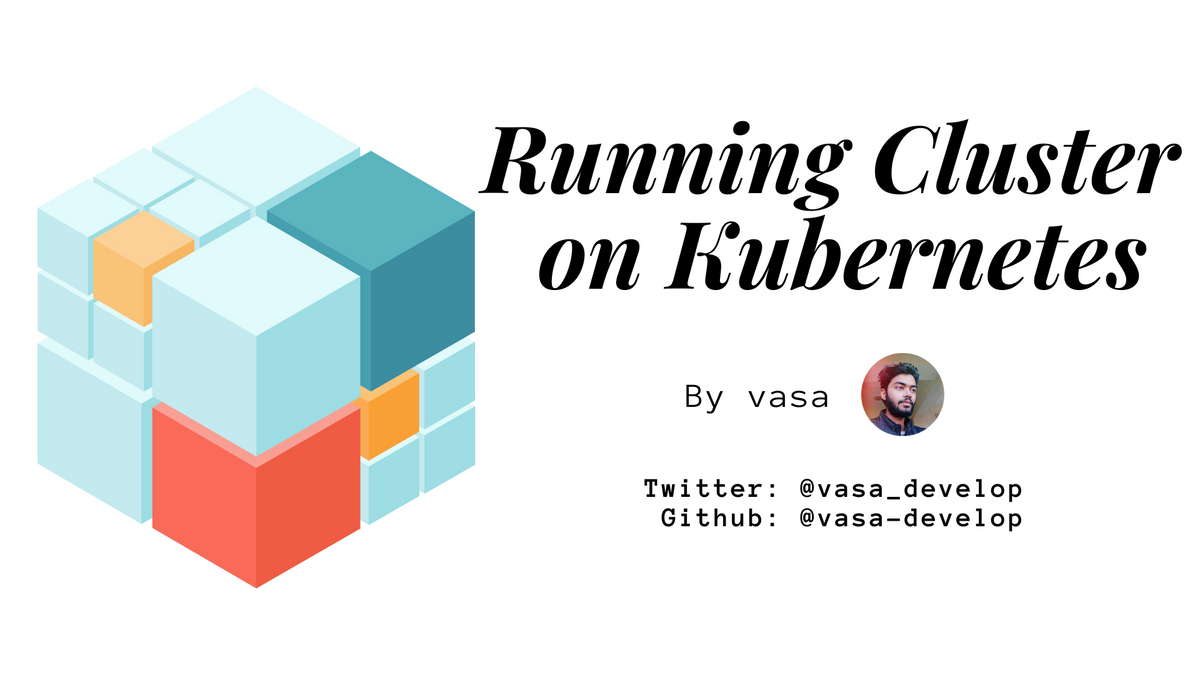Running Cluster on Kubernetes

This guide will show you how to:
- Run a simple Cluster on Kubernetes
- Using Kustomize, adapt the Cluster Kubernetes resources to your scenario
This guide assumes you have a running Kubernetes cluster to deploy to and have properly configured kubectlPrepare Configuration Values
Configuring the Secret Resource
In Kubernetes, Secret objects are used to hold values such as tokens, or private keys.
# secret.yaml
apiVersion: v1
kind: Secret
metadata:
name: secret-config
type: Opaque
data:
cluster-secret: <INSERT_SECRET>
Cluster Secret
To generate the cluster_secret value in secret.yaml, run the following and insert the output in the appropriate place in the secret.yaml file:
$ od -vN 32 -An -tx1 /dev/urandom | tr -d ' \n' | base64 -w 0 -
Bootstrap Peer ID and Private Key
To generate the values for bootstrap_peer_id and bootstrap_peer_priv_key, install ipfs-key and then run the following:
$ ipfs-key | base64 -w 0
Copy the id into the env-configmap.yaml file. I.e:
# env-configmap.yaml
apiVersion: v1
kind: ConfigMap
metadata:
name: env-config
data:
bootstrap-peer-id: <INSERT_PEER_ID>
Then copy the private key value and run the following with it:
$ echo "<INSERT_PRIV_KEY_VALUE_HERE>" | base64 -w 0 -
Copy the output to the secret.yaml file.
# secret.yaml
apiVersion: v1
kind: Secret
metadata:
name: secret-config
type: Opaque
data:
cluster-secret: <INSERT_SECRET>
bootstrap-peer-priv-key: <INSERT_KEY>
Defining a StatefulSet
From the Kubernetes documentation on StatefulSets:
Manages the deployment and scaling of a set of Pods, and provides guarantees about the ordering and uniqueness of these Pods.
Like a Deployment, a StatefulSet manages Pods that are based on an identical container spec. Unlike a Deployment, a StatefulSet maintains a sticky identity for each of their Pods. These pods are created from the same spec, but are not interchangeable: each has a persistent identifier that it maintains across any rescheduling.
This means for us, that any Kubernetes generated configuration, such as hostnames, i.e. ipfs-cluster-0, will be associated with the same Pod and VolumeClaim, which means for example, hostnames will always be associated with the same peer id that is stored in the ~/.ipfs-cluster/service.json file. And all this is important, because it allows us to bootstrap our ipfs-cluster without a spnning up a specific bootstraping peer.
Breaking the StatefulSet definition into chunks, the first is the preamble and start of the StatefulSet spec:
apiVersion: apps/v1
kind: StatefulSet
metadata:
name: ipfs-cluster
spec:
serviceName: ipfs-cluster
replicas: 3
selector:
matchLabels:
app: ipfs-cluster
Following that is the definition of the go-ipfs container:
template:
metadata:
labels:
app: ipfs-cluster
spec:
initContainers:
- name: configure-ipfs
image: "ipfs/go-ipfs:v0.4.18"
command: ["sh", "/custom/configure-ipfs.sh"]
volumeMounts:
- name: ipfs-storage
mountPath: /data/ipfs
- name: configure-script
mountPath: /custom
containers:
- name: ipfs
image: "ipfs/go-ipfs:v0.4.18"
imagePullPolicy: IfNotPresent
env:
- name: IPFS_FD_MAX
value: "4096"
ports:
- name: swarm
protocol: TCP
containerPort: 4001
- name: swarm-udp
protocol: UDP
containerPort: 4002
- name: api
protocol: TCP
containerPort: 5001
- name: ws
protocol: TCP
containerPort: 8081
- name: http
protocol: TCP
containerPort: 8080
livenessProbe:
tcpSocket:
port: swarm
initialDelaySeconds: 30
timeoutSeconds: 5
periodSeconds: 15
volumeMounts:
- name: ipfs-storage
mountPath: /data/ipfs
- name: configure-script
mountPath: /custom
resources:
{}
Take note of the initContainers section, which is used to configure the ipfs node with production appropriate values, see Defining Configuration Scripts.
Next we define the ipfs-cluster container:
- name: ipfs-cluster
image: "ipfs/ipfs-cluster:latest"
imagePullPolicy: IfNotPresent
command: ["sh", "/custom/entrypoint.sh"]
envFrom:
- configMapRef:
name: env-config
env:
- name: BOOTSTRAP_PEER_ID
valueFrom:
configMapRef:
name: env-config
key: bootstrap-peer-id
- name: BOOTSTRAP_PEER_PRIV_KEY
valueFrom:
secretKeyRef:
name: secret-config
key: bootstrap-peer-priv-key
- name: CLUSTER_SECRET
valueFrom:
secretKeyRef:
name: secret-config
key: cluster-secret
- name: CLUSTER_MONITOR_PING_INTERVAL
value: "3m"
- name: SVC_NAME
value: $(CLUSTER_SVC_NAME)
ports:
- name: api-http
containerPort: 9094
protocol: TCP
- name: proxy-http
containerPort: 9095
protocol: TCP
- name: cluster-swarm
containerPort: 9096
protocol: TCP
livenessProbe:
tcpSocket:
port: cluster-swarm
initialDelaySeconds: 5
timeoutSeconds: 5
periodSeconds: 10
volumeMounts:
- name: cluster-storage
mountPath: /data/ipfs-cluster
- name: configure-script
mountPath: /custom
resources:
{}
Note that BOOTSTRAP_PEER_ID and BOOTSTRAP_PEER_PRIV_KEY were the values we defined earlier, they will be used only be the very first ipfs-cluster container ipfs-cluster-0 and then BOOTSTRAP_PEER_ID will be used to pass the bootstrapping multiaddress to the other ipfs-cluster containers.
Finally, we define the volumes for the configuration scripts and also the data volumes for the ipfs and ipfs-cluster containers:
volumes:
- name: configure-script
configMap:
name: ipfs-cluster-set-bootstrap-conf
volumeClaimTemplates:
- metadata:
name: cluster-storage
spec:
storageClassName: standard
accessModes: ["ReadWriteOnce"]
persistentVolumeReclaimPolicy: Retain
resources:
requests:
storage: 5Gi
- metadata:
name: ipfs-storage
spec:
storageClassName: standard
accessModes: ["ReadWriteOnce"]
persistentVolumeReclaimPolicy: Retain
resources:
requests:
storage: 200Gi
Depending on your cloud provider, you will have to change the value of storageClassName to the appropriate value.
The StatefulSet definition as an entirety, can be found at github.com/lanzafame/ipfs-cluster-k8s.
Defining Configuration Scripts
The ConfigMap contains two scripts, entrypoint.sh which enables hands-free bootstrapping of the ipfs-cluster cluster and configure-ipfs.sh which configures the ipfs daemon with production values. For more information about configuring ipfs for production, see go-ipfs configuration tweaks.
apiVersion: v1
kind: ConfigMap
metadata:
name: ipfs-cluster-set-bootstrap-conf
data:
entrypoint.sh: |
#!/bin/sh
user=ipfs
# This is a custom entrypoint for k8s designed to connect to the bootstrap
# node running in the cluster. It has been set up using a configmap to
# allow changes on the fly.
if [ ! -f /data/ipfs-cluster/service.json ]; then
ipfs-cluster-service init
fi
PEER_HOSTNAME=`cat /proc/sys/kernel/hostname`
grep -q ".*ipfs-cluster-0.*" /proc/sys/kernel/hostname
if [ $? -eq 0 ]; then
CLUSTER_ID=${BOOTSTRAP_PEER_ID} \
CLUSTER_PRIVATEKEY=${BOOTSTRAP_PEER_PRIV_KEY} \
exec ipfs-cluster-service daemon --upgrade
else
BOOTSTRAP_ADDR=/dns4/${SVC_NAME}-0/tcp/9096/ipfs/${BOOTSTRAP_PEER_ID}
if [ -z $BOOTSTRAP_ADDR ]; then
exit 1
fi
# Only ipfs user can get here
exec ipfs-cluster-service daemon --upgrade --bootstrap $BOOTSTRAP_ADDR --leave
fi
configure-ipfs.sh: |
#!/bin/sh
set -e
set -x
user=ipfs
# This is a custom entrypoint for k8s designed to run ipfs nodes in an appropriate
# setup for production scenarios.
mkdir -p /data/ipfs && chown -R ipfs /data/ipfs
if [ -f /data/ipfs/config ]; then
if [ -f /data/ipfs/repo.lock ]; then
rm /data/ipfs/repo.lock
fi
exit 0
fi
ipfs init --profile=badgerds,server
ipfs config --json Addresses.API /ip4/0.0.0.0/tcp/5001
ipfs config --json Addresses.Gateway /ip4/0.0.0.0/tcp/8080
ipfs config --json Swarm.ConnMgr.HighWater 2000
ipfs config --json Datastore.BloomFilterSize 1048576
ipfs config Datastore.StorageMax 100GB
Exposing IPFS Cluster Endpoints
The final step for us is to define the Service which expose the IPFS Cluster endpoints to the outside the Pod.
apiVersion: v1
kind: Service
metadata:
name: ipfs-cluster
annotations:
external-dns.alpha.kubernetes.io/hostname: change.me.com
labels:
app: ipfs-cluster
spec:
type: LoadBalancer
ports:
- name: swarm
targetPort: swarm
port: 4001
- name: swarm-udp
targetPort: swarm-udp
port: 4002
- name: ws
targetPort: ws
port: 8081
- name: http
targetPort: http
port: 8080
- name: api-http
targetPort: api-http
port: 9094
- name: proxy-http
targetPort: proxy-http
port: 9095
- name: cluster-swarm
targetPort: cluster-swarm
port: 9096
selector:
app: ipfs-cluster
Depending on where and how you have set up your Kubernetes cluster, you may be able to make use of the ExternalDNS annotation external-dns.alpha.kubernetes.io/hostname, which will automatically take the provided value, change.me.com, and create a DNS record in the configured DNS provider, i.e. AWS Route53 or Google CloudDNS.
Also note that the targetPort fields are using the named ports from the PodSpec defined in the StatefulSet resource.
